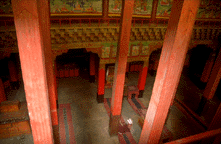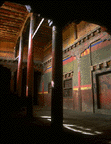(click on small images to view full screen with caption)
 |
| Palpung's main assembly hall, which was refurbished in 1991. |
E
ntering Palpung Monastery is like nothing so much as venturing into a haunted castle. Outside, high clay walls loom steep and impregnable. There is no moat, but a pack of mangy, semi-wild dogs patrols the perimeter. The visitor who gets past these (and who has therefore already scaled the 250-meter cliff that guards all but the northern approach), faces a pair of huge, heavy wooden doors that, likely as not, are closed. Even when unlocked, the doors need a muscular shove to open, and their wooden hinges issue a warning creak that alerts more dogs in the courtyard within.The prudent visitor has arranged an introduction to the monastery's keepers, and now an old wrinkled lama in grease-stiffened robes comes to greet you. Several others materialize from the shadows to help carry your bags upstairs.
Those who have visited Buddhist monasteries in Lhasa and elsewhere on the Tibetan plateau will doubtless find this description greatly at odds with their experiences. Most Tibetan monasteries are bee-hives of activity, their open doors admitting a constant stream of pilgrims, monks, and (nowadays) tourists. The main assembly hall is brilliant with butter lamps, richly decorated with sculpture, frescoes, and tapestries. Among the colleges, dormitories, and store houses of this miniature city monks bustle to and fro, always cheerful, always busy. These are just some of the sights and sounds that are part of a living monastery. Not so Palpung.
Since China's turn toward modernization, economic opening, and newly allowed religious freedom, a lot of Buddhist institutions have been rehabilitated. Tibetans, sometimes with government or other aid, have rebuilt many monasteries, erasing the most visible effects of the Cultural Revolution when worship was banned and many monasteries destroyed. But this religious resurgence has been slow to reach out-of-the-way places like Palpung, which lies 25 km from the nearest motorable road. Lamas were allowed to return in 1982, but the building itself, stripped of its gold embellishments on the outside and sacred treasures within, never regained its former glory. It is just too remote, too vast, and too complex a task for the limited resources available for restoration.
 |
| In 1991 the Situ rinpoche donated this 20-meter high statue of Maitreya, the Buddha to come, to Palpung. |
That's why it has attracted the attention of CERS. This architectural treasure, so huge and so magnificent that it has been called "The Little Potala Palace," simply cannot be allowed to crumble to dust. CERS President How Man Wong has undertaken to assemble a crack team of foreign and local experts which, together with funds to be raised among CERS supporters, will save this 300-year-old marvel.
The goal of my one-woman expedition this summer has been to provide a bridge between the information gathered by the 1991 CERS survey and the team that will start work this autumn. Last year an earthquake in western Sichuan gravely damaged critical structures that were already at risk from rain, rot, and neglect. For the work to proceed efficiently, British conservation architect John Sanday needs foreknowledge of what he will face. My task at Palpung was to document earthquake damage, assess supplies of labor and materials, and to prepare the stage for work that will commence in two months. Here is what I found.
Walking down the corridors of Palpung is indeed like exploring a medieval castle. The ceilings are high, the rooms great, but all are sunk into musty gloom. Black soot covers beamed ceilings and obscures antique frescoes. There are so few inhabitants that I seldom see anyone except my direct hosts. I live in a long disused shrine room, and store my gear on the shelves of a dusty cabinet that once housed sacred images. But most rooms are either empty or are littered with refuse. Windows, already small and admitting little light through their paper-covered wooden lattices, have been boarded up. Thus the monastery is a maze of dark, dungeon-like chambers too dark and uncomfortable for even rats to infest.
It's on the first floor that the earthquake damage is most apparent. The monastery's outer walls, although more than a meter thick, are riven with huge cracks; they begin by the foundation and spread all the way to the roof some 20 meters above. The northeast corner of the building is most severely affected; here a whole segment several rooms wide and five floors deep was lowered by seismic shaking to a position some 10 cm below the rest of the building. This has had a chain reaction effect all over the structure, inducing floors to tilt and walls to lean here and there throughout.
Poking around the foundation, I see that Shiongshiong, a local Tibetan engineer, has added columns to prop up sagging beams. But this stop-gap measure does nothing to restore Palpung to its proper shape, nor does it dispel the gloom that permeates every corner.
 |
| Grand entrance hall to Situ Rinpoche's quarters. |
There is some good news. The wood, stone, and clay that compose Palpung are largely sound. Joints are, in general, holding, and the building seems in little danger of immediate collapse. Below the monastery, by the river Baiqu, is a sawmill where four workers are finishing timber to be used in the building's restoration; the new lumber awaits only funds and expertise to be incorporated into a new Palpung.
But perhaps the most hopeful sign lies not in the realm of
engineering. On the third floor, from a window facing the courtyard, comes the gay sound
of childish laughter. It is Ugyen Rinpoche, five years
old, and his two brothers. The rinpoche, or "Living Buddha," son of nomad
parents and brought to Palpung last year, is a tiny angelic child, and seems oddly in
contrast with his aged tutor and the gloomy fortress in which he lives. I hope he learns
his lessons well, for his leadership is needed to draw people back to Palpung, and it's
people--even more than timber--that are essential to revive this venerable Tibetan
monastery.